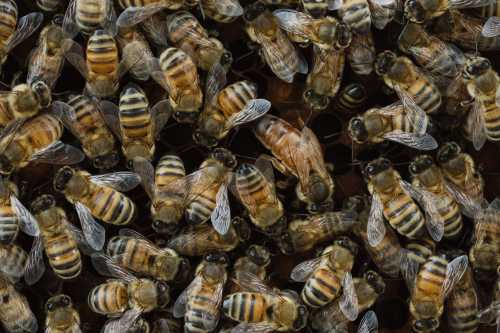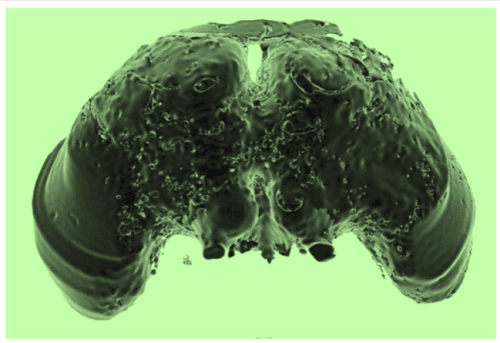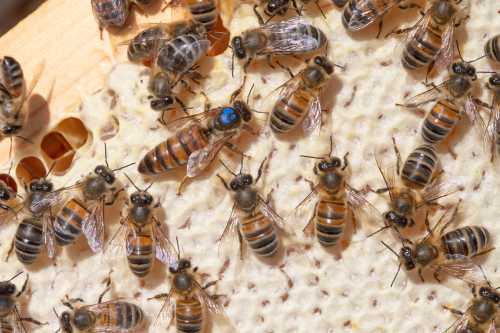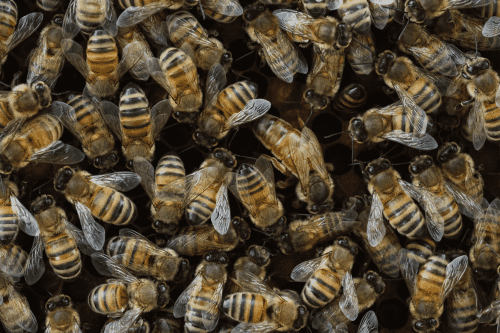Why Are Honey Bee Colonies Considered Superorganisms?
Superorganism-grade insect societies began to appear about 100 million years ago1.
Ants, termites and honey bees are often
described as 'superorganisms'.
Perhaps one
of the most famous writings on the subject is E. O. Wilson’s Success,
Dominance, and the Superorganism: The Case of the Social Insects (1997)
in which he suggests that highly integrated, social organisms could be
considered as a single unit – a superorganism.
What
is a superorganism?
A superorganism might be
defined as any aggregate of individual organisms that behaves like a unified
organism.
We might also describe a superorganism
as a group of interdependent individuals of the same species that thrives by interacting
in a synergistic way. Each individual
within the superorganism has a specific role to play and is highly dependent on
the other individuals performing their individual role successfully.
The Honey Bee Colony As A Superorganism

It is perhaps helpful to start with a quote from renowned bee-expert, Professor Thomas D. Seeley, author of Honey Bee Democracy and The Lives Of Bees:
“One way to think of a honey bee colony is, then, as a society of many thousands of individuals: the queen, workers, and drones just discussed.
But to understand the distinctive biology of this species of bee, it is often helpful to think of a colony in a slightly different way, not just as thousands of separate bees but also as a single living entity that functions as a unified whole.
In other words, it can help to think of a honey bee colony as a superorganism.
Just as a human body functions as a single integrated unit even though it is a multitude of cells, the superorganism of a honey bee colony operates as a single coherent whole even though it is a multitude of bees.”
In his paper, The Honey Bee Colony As A Superorganism2, Seeley also notes:
"A colony of honey bees, for example, functions as an integrated whole and its members cannot survive on their own, yet individual honey bees are physically independent."
Of course, it may be possible for an individual honey bee to survive for a short time outside a
colony. It can, after all, forage for nectar and
pollen from flowers.
However, honey bees are highly eusocial, and the survival of the honey bee species is dependent on the colony as a whole.
A honey bee cannot independently rear a
colony and produce new colonies to secure future generations of the species.
What characteristics do honey bee colonies and superorganisms share?
Here are some of the characteristics of superorganisms and how they apply to the honey bee colony.
1. Structural characteristics
Superorganisms are composed of many individual units.
In the case of the honey bee colony, the individual
units are of course, represented by each single bee that makes up the colony, including the
honey bee queen, the workers and the drones.
Within a superorganism, individuals have their own life cycles, with some living
longer than other types of cell, in the same way that bees share four key stages of development from egg, larva, pupa and then adult.
However, each individual adult completes its own life cycle and life expectancy differs for each individual.
2. Functional characteristics
Within a superorganism, individuals
perform different but essential functions. Similarly, within a honey bee colony,
different bee types (queen, worker, drone) perform their own set of essential tasks.
3. Social, organizational characteristics
Super organisms have the ability to regulate and maintain their internal environments, in order to reduce or eliminate any external environmental fluctuations.
Honey bees also cooperatively maintain and control the internal environment within the nest or hive, for example in controlling the temperature against external and internal fluctuations in winter by clustering, or in hot or dry condition, with the collection and distribution of water.
4. Long-term survival of the whole
In superorganisms, an individual member
of that organism would not survive
outside the integrated whole - see Which bee in a honey bee colony is most important?
As described above, individual bees could not survive for long outside the colony (for example, drones are evicted and ultimately perish). At the very least, they could not perpetuate the survival of the species, because they would be unable to create a nest and rear a colony alone.
References And Resources
1. Burnham, Laurie. (1978). Survey of Social Insects in the Fossil Record. Psyche. 85. 10.1155/1978/80816.
2. Seeley, Thomas D. “The Honey Bee Colony as a Superorganism.” American Scientist, vol. 77, no. 6, 1989, pp. 546–553. JSTOR, www.jstor.org/stable/27856005. Accessed 3 July 2021.
3. Robin F.A. Moritz, Stefan Fuchs.
Organization of honeybee colonies: characteristics and consequences of a superorganism
concept. Apidologie, Springer Verlag, 1998, 29 (1-2), pp.7-21. ffhal-00891477f
If you found this page helpful or interesting, I'd really be grateful if you would share it with others - if not this page, perhaps another, such as Gardening For Bees.
Thank you so much :) .


